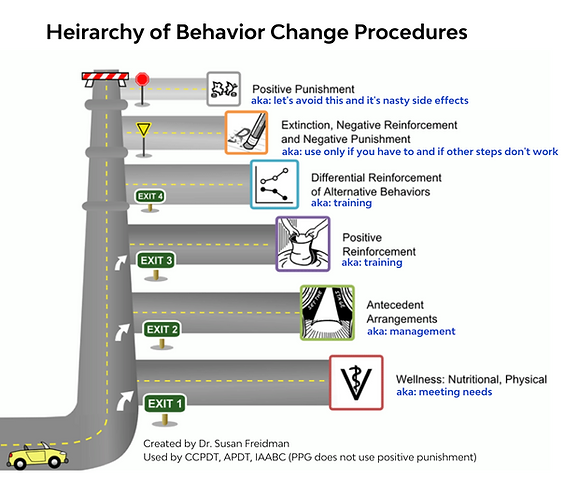Behavior Change
Meeting Needs & Behavior Change
Meeting our dog's needs is critical to having a happy, healthy dog who thrives in a human family. Our dogs have behaviors normal to their species that need to be expressed. If our dogs don't have outlets for these normal behaviors, unwanted versions of the behavior or nuisance behaviors may appear.
Expressing Normal Behaviors
Your dog needs to express normal dog behavior, including barking, running, chewing, digging, sniffing, playing & chasing. When any of these behaviors happen too frequently or too intensely, or not enough or towards the wrong thing (like the remote), they can become a problem for humans or even other dogs. Fortunately, we can significantly influence these behaviors with a little bit of knowledge, management and training.
.png)
.png)
Each day, the amount of need to express the different, normal behaviors changes. Many factors influence the changes, including how much or little it's been done recently. Some dogs have a higher need to do some of these behaviors, like chew, chase, or sniff, than other dogs based on genetics and breed. Your dog may amped up or be tired and not want to do anything. Behavior problems occur when the need is high but there is no 'legal' outlet.
An Example using Chewing
Let's look at Scruffy and his needs to chew on things. In the graphic below, the degree that the cup is full equates to the strength of the need to chew at a particular time. Frustrated Scruffy needs to chew so badly that he may chew the house down or express this need in some other undesired way. Our Edgy guy is on the way to Frustrated - be careful! Unwanted behavior may be coming soon.
.png)
would like to chew something but happy doing other things too
just finished chewing, need is met
the need to chew overrides other needs
If chewing doesn't happen soon, the dog will meet their need on their own
Management, Meeting Needs & Training
So we have an unwanted behavior. What to do? Let's talk about how we approach behavior change.



First, we use management to prevent the problem from happening. This is important because we don't want your dog to practice undesired behaviors - the more it's practiced, the more reinforcement occurs for doing it, and the behavior gets stronger. Management includes supervision and putting stuff up.
Next, let's make sure your dog's needs are met. In the next section, we explore what can happen if you don't.
After management and needs meeting comes training. In the context of chewing, training is trading for desirable, legal options like bully sticks, dog toy, etc. This means, show your dog what to chew instead of what not to chew.
EXAMPLE
The example below relates to how apply this to a dog with undesired chewing behaviors.
Management
Put Stuff Up
If you don't want it chewed, put it up. Some things can't be put up like the sofa, so it's important to provide options for things ok to chew.
If your dog keeps going back to the same thing - like a wooden chair leg, prevent access with gates.
Meet Needs
Exercise
Make sure your dog's needs are met. This goes for both physical and mental exercise.
Long, sniffy walks are great for the brain - so are nose work games. Training using positive reinforcement will also work that grey matter.
Management
Supervise
Keep an eye on your dog, even when with you. If you can't supervise - use a safe confinement area and an enrichment item.
When you have to leave the house, crate or confine your dog and provide a few chew options like a hidden frozen Kong, a bully stick or bone.
Training
Trade
If you catch your dog chewing on something that's undesired or "illegal", trade her for something both terrific and legal. No need to make a fuss, just show your pup what you'd like to be chewed instead.
This is chew training. Train your dog what to chew ('legal') instead of what you don't want chewed.
Interested in the Science behind these Recommendations? Read on...
A Deeper Dive into Your Dog's Needs
Like us, our dogs have needs. Each layer of needs requires the layer on which it stands for the dog to have all its needs met.
.png)
The Impact of Unmet Needs
If we don't meet our dogs needs, sometimes there are behavioral consequences.
Normal dog behavior such as chewing, digging, playing, etc. falls throughout the hierarchy.
Back to our chewing example - if the biological need of chewing is not met, we may see some destructive behavior.
.png)
Changing Undesired Behavior
This graphic, created by Dr. Susan Friedman, shows the desired way to approach dealing with undesired behavior.
We added the blue text in the graphic to correlate these procedures to our earlier discussion:
Exit 1 - Meeting needs (take this approach first!)
Exit 2 - Management
Exit 3, 4 - Training (keep it kind!)

If your dog has a behavior that you'd like to change, start first with analyzing needs and do a health check. Next,
-
address unmet needs
-
implement management to prevent practice
Finally, train your dog with the most appropriate plan using positive reinforcement.
